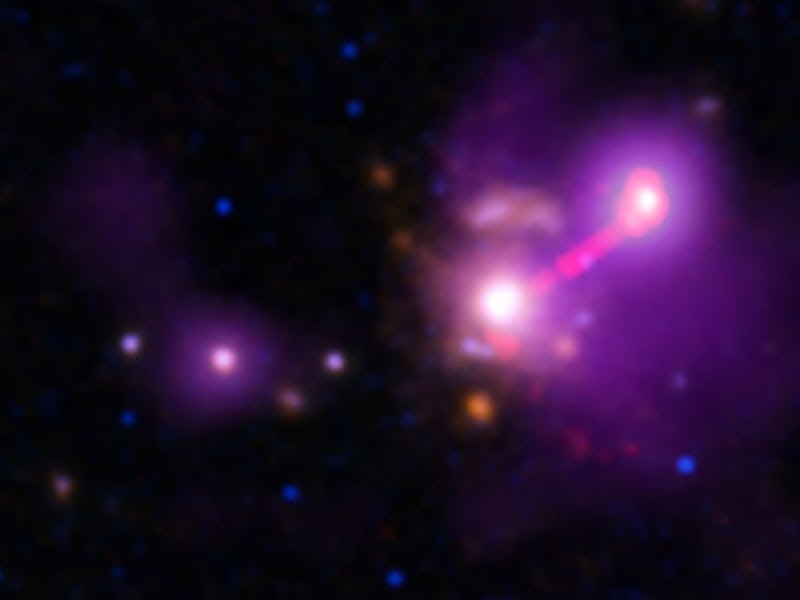NASA Uncovers a Massive Galactic Mystery 9 Billion Light-Years from Earth
X-ray and optical telescopes suggest that an ancient galaxy gobbled up its neighbors and likely lives alone in the distant Universe.

The bright, churning heart of ancient galaxy 3C 297, visible just right of center in a new NASA image, has fascinated astronomers. And when Valentina Missaglia, a postdoctoral researcher at the Institute of Astrophysics at FORTH in Greece, led a team to peer into the invisible world of X-ray and radio emissions surrounding the galaxy, she found something unexpected. Inspired by the data, the team titled their December 2022 study in The Astrophysical Journal with vivid descriptors for the galaxy: “powerful yet lonely.”
The supermassive black hole at the core of galaxy 3C 297 is quite a spectacle. It superheats the material around it to glow brightly as a quasar, and also churns out a 140,000 light-year-long jet that is larger than the Milky Way and the galaxy itself. But it turns out that the region around 3C 297 is filled with caches of emission data suggesting to researchers this solitary object may have had companions which are no longer there.
Missaglia postulates that this one bright galaxy is a fossil, a single epic remnant of a former cluster of galaxies whose stellar masses have combined into one galaxy. “The environment of this galaxy … appears to have the key features of a galaxy cluster, enormous structures that usually contain hundreds or even thousands of galaxies. Yet 3C 297 stands alone,” Chandra officials wrote in a statement published Wednesday.
NASA’s Chandra X-Ray Observatory in space and the two Gemini Telescopes in Chile and Hawaii took observations that helped reveal otherwise invisible clues about 3C 297, located 9.2 billion light years away in the Virgo constellation.
An annotated view of 3C 297, located more than 9 billion light years from Earth in the Virgo constellation.
“It seems that we have a galaxy cluster that is missing almost all of its galaxies,” Missaglia shared in the Chandra statement.
The problem is gas. Galaxy clusters contain hot gas. It reaches temperatures high enough to emit X-rays, triggered when a cluster forms. This halo of gas lingers, remaining visible long after it formed due to its lengthy cooling time and its interaction with active galactic nuclei like the supermassive black hole at the heart of the lonely galaxy.
And Missaglia’s team found a lot of evidence for this hot gas in the Chandra observations.
The X-ray data revealed “large quantities of gas with temperatures of tens of millions of degrees — something normally seen in galaxy clusters,” Chandra officials wrote in the statement.
More clues came from the black hole’s galaxy-sized jet. It revealed the existence of gas surrounding the galaxy when it “plowed” into the material to produce an “intense source of X-rays about 140,000 light years away” from the black hole. Another hint is the bend of another black hole jet, whose shape shows it interacted with some substance.
The signs of a galaxy cluster were there, and in fact, the Chandra X-ray data supported an expectation of a cluster filled with at least 100 galaxies. But when the Gemini telescopes looked in optical light, the team found no galaxies at the same distance as the single bright galaxy.
Astronomers use the word “fossil” to describe when a giant elliptical galaxy — a late stage of galactic evolution — is alone, like 3C 297, without companions but rife with hot gas. “The [galactic] companions have, indeed, merged to form one entity in the early Universe,” Missaglia wrote in her Chandra blog post published Tuesday.
It’s possible that small imperceptible galaxies could be the unseen members of this ghost cluster. But Chandra officials write that their presence around 3C 297 “would still not explain the lack of larger galaxies” that ought to be there.
This article was originally published on